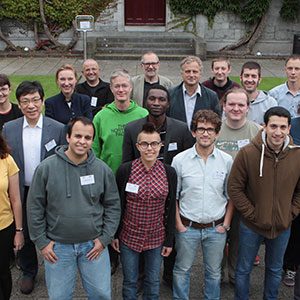-
Cúrsaí

Cúrsaí
Tá roghnú cúrsa léinn ar cheann de na cinntí is tábhachtaí dá ndéanfaidh tú choíche! Féach na cúrsaí atá againn anseo agus an méid a deir mic léinn agus léachtóirí faoi na cúrsaí sin a bhfuil spéis agatsa iontu.
-
Saol na hOllscoile

Saol na hOllscoile
Chuile bhliain roghnaíonn os cionn 4,000 duine Ollscoil na Gaillimhe mar chéad rogha. Faigh amach faoin saol in Ollscoil na Gaillimhe anseo.
-
Eolas Fúinn

Eolas faoi Ollscoil na Gaillimhe
Bí ar an eolas faoin Ollscoil seo agus na fáthanna a bhfuil sí chomh speisialta sin – an stair thar a bheith spéisiúil a bhaineann leis an Ollscoil agus an nuacht is déanaí agus na hócáidí atá ar na bacáin.
-
Coláistí & Scoileanna
- Scoil na Tíreolaíochta, na Seandálaíochta agus Léann Éireannaigh
- Coláiste an Ghnó, an Bheartais Phoiblí & an Dlí
- Coláiste an Leighis, an Altranais & na nEolaíochtaí Sláinte
- Coláiste na hEolaíochta agus na hInnealtóireachta
- Scoil na dTeangacha, na Litríochtaí agus na gCultúr
- Roinn na Gaeilge
- An tAcadamh
- Stair
- Idirnáisiúnta

Coláistí & Scoileanna
Tá aitheantas idirnáisiúnta bainte amach ag Ollscoil na Gaillimhe mar ollscoil atá á treorú ag an taighde agus rún daingean aici teagasc den chéad scoth a chur ar fáil i réimsí éagsúla saineolais.
-
Taighde

Nithe Fónta á gCruthú as Smaointe Úra
Tugann ár dtaighdeoirí aghaidh ar chuid de na dúshláin is práinní san 21ú Céad.
-
Gnó & Tionscal

Tacaíocht do Thaighde Úrnua in Ollscoil na Gaillimhe
Déanaimid deiseanna tráchtála a chuardach agus a chothú don phobal taighde in Ollscoil na Gaillimhe, mar aon le comhpháirtíocht tionsclaíochta a chothú.
-
Alumni, Cairde & Lucht Tacaíochta

Alumni, Cairde & Lucht Tacaíochta
Tá os cionn 90,000 céimí de chuid Ollscoil na Gaillimhe ann ar fud an domhain. Déan nasc linn agus beidh teacht agat ar an gcomhphobal sin ar líne.
-
Rannpháirtíocht Pobail

Rannpháirtíocht sa Phobal
In Ollscoil na Gaillimhe, creidimid go n-éireoidh níos fearr leat más féidir leat an méid a fhoghlaimíonn tú a chur i bhfeidhm i do shaol féin. Is mar gheall air sin go bhfuil béim mhór ar shocrúcháin oibre nó ar thionscadail phobail i gcuid mhór dár gcúrsaí.
Nuacht
Advanced technology offers revolutionary coronary care
Harnessing AI would enable advancement of cardiovascular care for millions, with greatest impact in the developing world Pioneering technology offers physicians more accurate understanding of heart condition, leading to better patient outcomes A world-leading interventional cardiologist and researcher at University of Galway has called for a revolutionary change in healthcare – with artificial intelligence, machine learning and virtual reality to be used to better diagnose and treat cardiac patients. Professor of Interventional Cardiology William Wijns, along with international colleagues from China, Italy, Switzerland and the USA, is urging the adoption of the most advanced technologies to empower clinicians to uncover previously concealed information within a coronary angiogram. Professor Wijns made the call in a specially commissioned article in Nature Review in Cardiology. In the paper, Professor Wijns emphasised the limitations of relying solely on traditional visual angiographic guidance for diagnosis and treatment of coronary artery disease. He cited previously published research which showed that diagnosis and treatment through the cardio-angiogram led to inappropriate stenting and overtreatment in 37% of patients; that 30% of interventional procedures are deemed unnecessary; and 20% are found to be needed but not performed. Stenting, although a common procedure, comes with potential problems to the patient, such as restenosis, thrombosis, damage to blood vessels and other risks. When the cardiologist uses angiographic images to precisely navigate catheters through arteries, results are not always optimal - about 50% of patients end up with suboptimal functional outcomes, leaving them vulnerable to further heart issues in the short and long term. Professor Wijns explained: “It is time for a paradigm shift in how we diagnose and treat coronary patients. We have good evidence that a new approach, taking into account the unique physiological characteristics of each patient’s heart, allows for more precise and effective treatment decisions. By integrating advanced technologies, such as artificial intelligence, into the interventional procedures, physicians can obtain a more accurate understanding of the heart's condition, leading to better patient outcomes, reducing the risk of adverse events, and preventing subsequent problems.” Research contends that recent advances in AI, machine learning and virtual reality can empower interventional cardiologists to uncover previously concealed information within a standard cardio-angiogram. This additional information holds significant implications and advantages for patients, providing a deeper insight into their individual condition. Blockages in smaller blood vessels in particular can also now be uncovered from image based AI. This new approach enables a more tailored response and treatment approach. This advancement will enable physicians to refine patient treatments, resulting in enhanced interventions compared to traditional angiograms, that don’t use AI assistance. Professor Wijns continued: “While the integration of artificial intelligence into coronary disease diagnosis and treatment planning represents a significant step forward in boosting accessibility on a global scale, it has never been more important to increase access to resources. Our new approach is refining the understanding of how blockages and other obstacles are impeding normal blood flow to the heart. Enabling access to this AI-led approach will advance cardiovascular care in emerging nations, bridging the gap with the first world and fostering substantial global impact, while also decreasing differences in quality of care in centres in the developed world. “Additional research is currently underway to validate the effectiveness of these new strategies, and we are optimistic about the potential to revolutionise care of coronary artery disease and improve the lives of millions of patients worldwide.” The paper can be accessed here: https://doi.org/10.1038/s41569-024-01014-0 Ends









